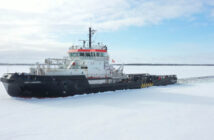A accident was avoided near Port Huron, Michigan, thanks to a series of alarm horns from Canada’s bulk carrier Cuyahoga making a rapid turn towards the bridge and a last-minute move by the sail boat. This video serves as a stark reminder of how deadly the St. Clair River’s mouth can be. With such a powerful river, unbound vessels like the Cuyahoga must travel at nearly full speed just to keep up with the current and make some tight turns. It’s easy to see how there were so many collisions over the years, especially when there were even more vessels navigating the waterways.
The St. Clair River is a 40.5-mile-long (65.2-kilometer) river in central North America that flows from Lake Huron to Lake St. Clair, constituting part of the international border between Ontario, Canada, and Michigan, United States. The river is an important part of the Great Lakes Waterway, which allows cargo ships to move between the upper and lower Great Lakes via shipping channels.
The river, which some regard as a strait, travels in a southerly direction, linking Lake Huron’s southern end to Lake St. Clair’s northern end. Near its mouth in Lake St. Clair, it splits into multiple channels, forming the St. Clair Flats, a large delta region. The river, like a strait, acts as a narrow waterway that connects two bigger bodies of water. From Lake Huron to Lake St. Clair, the height declines 5 feet (2 metres). The average flow rate is 182,000 cubic feet per second (5,200 m3/s), with a drainage area of 223,600 square miles (579,000 km2) which includes the combined drainage regions of Lakes Huron, Michigan, and Superior.
Back in the Day
French voyageurs and coureurs des bois sailed the river in the 18th century to trade with the Ojibwa and other nearby Native Americans to deliver furs in canoes to major French and British trading posts, such as Fort Detroit, which was erected in 1701 below Lake St. Clair. Until the 1830s, European demand for American furs, particularly beaver, was great.
Wooden ships built in Port Huron and Marine City, Michigan, ferried immigrants up the river and west through the upper Great Lakes on their route to new homes in the American West during the mid-nineteenth century and beyond. Log rafts were used to transport lumber harvested on Michigan’s Thumb downriver to Detroit for processing and export.
Lake steamers carried passengers and travelled between tiny communities along the St. Clair and Detroit rivers, as well as around the Great Lakes, in the early twentieth century. Lake freighters, increasingly made of steel, cruised throughout the Great Lakes during the twentieth century, bringing commodities such as iron ore from the Mesabi Range, copper, and grain, all of which were the result of settlers’ labour. Grain was frequently sent through to large eastern markets such as Cleveland and New York City, while iron was taken to Ashtabula, Ohio and other industrial cities for processing and steel fabrication.
On both sides of the St. Clair River, much of the shoreline is urbanized and heavily industrialized. At the northern end of the river, intensive development has occurred in and near the neighbouring communities of Port Huron, Michigan, and Sarnia, Ontario. South of Sarnia, the most dense concentration of industry, including a massive petrochemical complex, may be found along the Ontario shore. Sarnia was founded as a fur trade center in the past.
The St. Clair River is a binational Area of Concern (AOC) that straddles the US-Canada border. An AOC is a section of the Great Lakes that has been ravaged by environmental degradation. Conventional pollutants such as microorganisms, heavy metals, toxic organics, contaminated sediment, fish consumption advisories, damaged animal and plant life, and beach closures made the St. Clair River an AOC.
Video Posted Originally @ Great Lakes Ship Watchers On Facebook.








